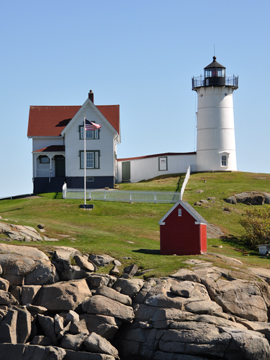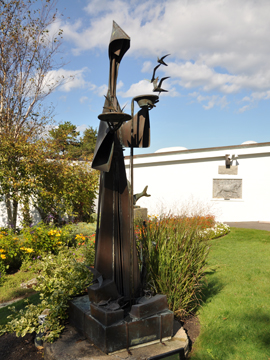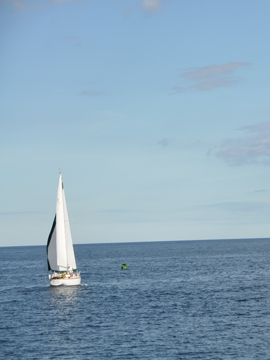a lighthouse, francis of assisi, and a sailboat
September 24, 2009
We left Reading and headed north on I-95. (I remember using I95 to get back and forth between New York and DC, New York and Providence, New York and Boston. Back then it seemed the only route through the north east.) We were on our way to Maine, to Ogunquit to be exact.
 Our first stop was to see a lighthouse outside of Ogunquit. The image is deceptive, because the lighthouse is on an island that visitors cannot access and there is a channel between the island and the visitors parking lot. This was my first look at the Maine seacoast – a rugged thing with stone fingers poking out into the cold Atlantic.
Our first stop was to see a lighthouse outside of Ogunquit. The image is deceptive, because the lighthouse is on an island that visitors cannot access and there is a channel between the island and the visitors parking lot. This was my first look at the Maine seacoast – a rugged thing with stone fingers poking out into the cold Atlantic.
My great worry with this trip was that I would not be able to figure out how to shoot nature as structure and what I found was that south eastern Maine is man-made; it has been conquered even if temporarily. Man has built beautiful structures on the rugged stones that cut into the mighty Atlantic. This lighthouse is about man building in the elements, man controlling for the violence of Neptune. The white is as bright as any wash in Panarea.
The structures here in south-eastern Maine are elegant, minimal and strong, because they have to live with the winds off the Atlantic. There is no room for embellishment, for Victorian gewgaws, a hurricane would make short shrift of any and all appendages. Even the colors used to paint the wooden structures are minimalist – pigment is used sparingly. But the red roof, the red building can be seen for miles.
 Francis of Assisi in Maine, there’s a non sequitur. On our way into Ogunquit I saw a sign for a Franciscan Monastery and asked Mac to pull in. He said he had wanted to see the grounds for a while but had never stopped. The place had a 1950 retreat house, much like the novitiate Mac and I lived in at Narragansett, an old mansion that was converted into a chapel, and the grounds had devotional places where the faithful could stop and pray.
Francis of Assisi in Maine, there’s a non sequitur. On our way into Ogunquit I saw a sign for a Franciscan Monastery and asked Mac to pull in. He said he had wanted to see the grounds for a while but had never stopped. The place had a 1950 retreat house, much like the novitiate Mac and I lived in at Narragansett, an old mansion that was converted into a chapel, and the grounds had devotional places where the faithful could stop and pray.
The chapel was a beautiful example of 1970’s Catholic design, a legacy to Sister Corita Kent the artist whose works became the symbols of the social upheavals of that period.
The sculpture of Francis was at the Ogunquit museum. What are two references to Francis doing in Maine, they’re supposed to be in Italy. The sculpture was a great find and a great surprise, because it captures the simplicity and power of that simple man from Assisi.
The sculpture is a fountain. The birds light on the bowl and drink. The water drips down gently from the bowl into the earth. The vertical lines are rigid and pull the eye up into the sky. Eventually it will patina green and blend into the landscape.
 While at the museum I went out into the gardens facing the Atlantic and saw a sailboat going out, so I started shooting. Only later looking at the pictures on the laptop did I discover the stripe on the sail. I’ll never understand people who leave the land and go out into the sea. (Remember, I came from a medieval hilltop town.) So I always look at sailboats as structures in a sea of blue.
While at the museum I went out into the gardens facing the Atlantic and saw a sailboat going out, so I started shooting. Only later looking at the pictures on the laptop did I discover the stripe on the sail. I’ll never understand people who leave the land and go out into the sea. (Remember, I came from a medieval hilltop town.) So I always look at sailboats as structures in a sea of blue.
Sailboats were everywhere, but so were the working boats of local fishermen going out every morning to where the ocean is deep. As a land-person I can’t picture what it must be like to be in the middle of blue vastness having no idea if there are fish below when bringing back fish is your livelihood your family’s income.
What was surprising was the green stripe on the one sail. I don’t think I saw it white shooting, rather for a split second, the wind turned to sail enough to get the stripe. The buoy to the right of the sail boat was a light green and nice contrast to the dark green stripe. The image, for me, is also about loneliness and fear two words I don’t combine when thinking about land-side environments.